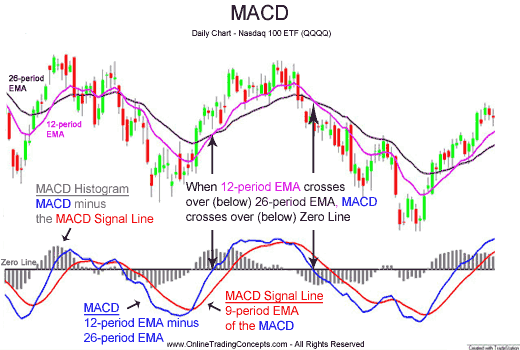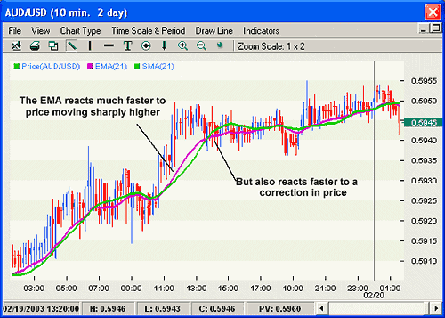Exponential Moving Average (EMA)
Post on: 23 Июнь, 2015 No Comment

Exponential Moving Average (EMA)
Indicator Name. Exponential Moving Average, Exponentially Weighted Moving Average, or simply EMA
Indicator Type. Moving Average
Description. Along with the simple moving average. the exponential moving average we are going to discuss here is one of the most commonly used technical chart indicators across all financial markets. The forex is no exception. The main reason that early chartists developed the exponential moving average was that they felt the SMA was too reliant on old data, and too slow to react to recent price action, so they devised a way to give the most weight to the most recent price action, and to let the weight taper off as you move back through time on the chart. There are two slightly different methods one can use to calculate an EMA, although it is fairly easy to convert from one form to the other.
Calculation. Method 1. The EMA calculation is quite a bit more complex than its simpler sibling, the SMA. It is best calculated recursively by the following formula:
where
EMA(0) is the current period’s exponential moving average value — the number we are trying to calculate
k is a value between 0 and 1, and is the weight given to the current period’s price. It is the EMA’s only user-defined parameter.
P(0) is the closing price for the current period
EMA(-1) is the previous period’s exponential moving average value
You will see immediately that the equation is recursive in nature — the current value depends on the previous period’s value, which in turn depends on the previous previous value, which in turn depends on the period before that, etc. In theory, there is no end to this cycle. In practice however, this has to stop when we reach the first period in our data feed. At that point we simply use that period’s price as the previous EMA value.
Another way to write this equation would be:
When we write it this way, we can easily see that the weight given to each successive price as we move back in time on the chart, becomes less and less, because 0<1 (k is a percent, so it can only have a value between 0 and 100%, or 0 and 1) and n>0. We can see that for all practical intents and purposes, we don’t need to go all the way back to the beginning of our data feed in order to get an acceptably accurate EMA — beyond a certain point, the weights given to older prices are so close to zero, that they can safely be neglected without affecting our result.

This leads us to:
Method 2. We now know we can cut the recursive EMA calculation off once the [1-k] n factor becomes sufficiently close to zero so that we can ignore it. This point comes when
where N is the Period of our EMA. This is the more common way of calculating the exponential moving average, and is the method found in most forex trading platforms, meaning that the user defines the period N, and not the weighing factor, or multiplier k. It should be noted that a true exponential moving average does not actually have a period, since in theory it takes into account all past data, but a period can be assigned regardless because the weight given to the older data is so small as to be insignificant.
Most Common Settings. Shorter period EMA calculated on closing price — the EMA tends to be more effective on shorter timeframes.
Strengths. As a result of more weight being given to more recent price action, exponential moving averages are quicker to react to price movements than simple moving averages. This allows systems based on EMA get into trades fairly early. As a result, the number of signals is quite high as compared to SMA-based systems, and the gains per trade can be substantial if you can get into the trade early on as trends are just developing, which is what the EMA was designed for. EMA’s also can’t be criticized for being selective, since they take into account all past data (in theory, anyway), as opposed to a rigidly set period.
Weaknesses. Because they produce many signals, and try to anticipate trends very early on in their formation, exponential moving averages are susceptible to fake-outs. Instead of waiting for a trend to establish, EMA systems try to anticipate the trend rather than follow it, which carries with it a significant risk of being wrong about the direction or existence of the trend.














